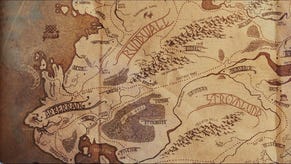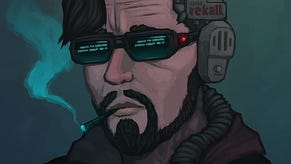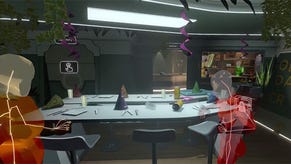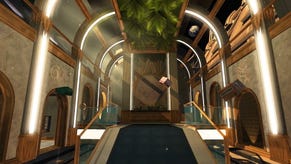Fullbright On The '90s, How Many Guns Gone Home Has
Home Is Where The Family Isn't, Pt 1
I recently had the privilege of putting on my '90s-appropriate detective hat and rifling through all sorts of (metaphorical - and some literal) dirty laundry in The Fullbright Company's Gone Home. It felt a bit like a blend of Fallout 3's environmental sleuthing and BioShock 2: Minerva's Den's brilliantly down-to-earth approach to storytelling. In other words, I resented Fullbright co-founder Steve Gaynor for eventually ending my demo session - with every fiber of my being. So of course, we did what people who resent each other always do: sat down for polite conversation. Along with the rest of the four-person Fullbright team, we discussed '90s culture, how games can be interesting even when totally devoid of action, exploring non-traditional topics in videogame stories, whether or not notes, audiotapes, and things of the like are a storytelling crutch, and of course, how many guns Gone Home has.
RPS: So how many guns is it gonna have?
Steve Gaynor: Well, as you might have noticed, we haven’t gotten to the guns yet, but we’re hoping. It might be like a day one patch. [laughs]
RPS: But seriously… One of the things I noticed first was that it’s set in the ‘90s, which is an interesting time period. A lot of games don’t go to that specifically. Why did you pick the ‘90s?
Steve Gaynor: It’s true. It’s not something that’s being explored a lot as a setting. The Darkness, the first one, was actually set in whenever those comics originally came out. They never really talked about it, but whenever you got a phone call, it was on a big white Seinfeld-like cordless phone, which was kind of awesome. I always remembered that, because there was that weird sense of the very recent past being re-created through these little touchstones you remember. That kind of cordless phone or whatever.
And so for us, we knew that we wanted to make a game that was about exploring a house that had been recently occupied. It wasn’t a ruin that had been sitting around for 20 years or something. People had just left and you were trying to find out what had happened to them. And we wanted to make something that felt as contemporary as possible. Something that happened within our own lifetimes. Not like a distant historical setting. For us it was like, “Okay, how recent can we make it before all the interesting information you would find in the house would all just be in e-mail and text messages? Before the time when there wouldn’t be notes lying around or any answering machines.”
Kind of ’94-’95, when the story takes place… Maybe this family doesn’t have AOL yet. [laughs] They’re still writing things down on paper and you can find it and read it. Between being able to think back to experiences from our own life and be able to re-create that – that sense of authenticity – and the practical concerns, it seemed to be the place that would make sense to set the game.
RPS: Conversely, how did having it set in the ‘90s feed back into the story you had plotted our for this?
Steve Gaynor: So, ways that the ‘90s fit into the specifics of the story are stuff like… For instance, Sam, at the beginning of the story, is more of a sheltered kid. Then she meets this friend of hers who’s into stuff that she’s never been exposed to before, like riot girl bands, Bikini Kill or Heavens to Betsy. That kind of music that was very new at that time and totally relevant to a young woman who’s finding about all these issues for the first time in this music that she’s never heard of before.
Stuff like the I WANT TO BELIEVE poster in her room. Aspects of the culture of that time that we’re familiar with and we remember say as much about her - “Oh, she’s into this and she connects with this” – as any of the actual dialogue in the audio diaries or whatever. The time period and that stuff… Having been around for a long time, being something a lot of people are familiar with, helps that stuff communicate what the characters are all about.
RPS: The whole tone of it felt kind of vaguely creepy, but not like something is going to jump out and attack me creepy. Why did you decide to go with that? Why set it on a Dark And Stormy Night?
Steve Gaynor: Part of it is art. Kate and Karla building the stuff like the house, the stuff you see in the house. Some of it’s sound. Again, a familiarity with that feeling of being in a house when it’s the middle of the night and it’s dark and nobody’s around. That loneliness is inherently slightly unsettling.
Okay, basic level, we want to make an empty house that you explore and find stuff in. Just being in that situation is a little bit weird. Nobody’s here, but this is where people lived. In a way we wanted to emphasize that, by having it take place at night in this storm with the electricity not always quite working right. Part of it is just supporting the feelings that are already going to be there.
The other side of it is, it’s not a combat game. It’s not a horror game in the way that Amnesia is or whatever. You’re not in actual danger. But it’s important to have a feeling of tension or unease when you’re playing. To feel like there’s something at stake. Even if it’s really just your imagination. What draws you through the game is your interest in the story you’re finding and the feeling of exploration, but that unease and not feeling quite right about the whole thing is what helps hold your attention.
The game’s about mystery. Feeling like everything isn’t quite right, atmospherically as well as in the beats of the story, is important.
RPS: Yeah. That’s definitely one of the big things I noticed. I was compelled to keep picking up stuff and reading and consuming information. There was an element of that in Minerva’s Den, but what was pulling me along in Minerva’s Den was still the action.
Steve Gaynor: It’s interesting. We’ve had a lot of people that we know playtest the game and help us make it better, give us feedback on it. We’ve had people mention… “I normally don’t really care about the story in games. I normally don’t pick up any of the books in Skyrim or whatever. But I was really” - like you said - “compelled to keep finding stuff and learning more.” For us, it was partially the potential and the promise of those aspects of Minerva’s Den or other games like that, that inspire us.
Part of the experience is going around and finding out the backstory, exploring and learning stuff, but a lot of it is still, “And then you shoot a hundred dudes.” And then you find some more of the human story. We just took a gamble on saying, “That stuff, the exploration and the discovery and the human aspect of those games that we love, is enough to support the entirety of the experience.” We believe that if we make our environments denser with that kind of content than most other games can be – because they have to support all these other aspects – and we weave in a story that we care about with those environments, that people will get hooked and, like you’re saying, want to find out more. Without numerical kinds of incentives – leveling up and getting more ammo and buying new upgrades.
Johnnemann Nordhagen: I also think there’s a sense in which the player can kind of tell where the attention of the game creator is. I guarantee that even the very lore-heavy games like Skyrim spent a lot more man-hours on the combat system than they did on the lore. As a player you can detect that. You know that this is where they spent their money and this, by extension, is what’s important to them. By removing that as a distraction, we can focus all of our attention on what we think is important. That, then, is no longer distracting to the player as well.
RPS: The beats hit in the story aren't typical game subjects at all. The themes. Why did you want to tell this story in the form of a game? Is mid-'90s suburbia going to become the new modern military battlefield?
Steve Gaynor: What aspects of it jumped out of you? What are you thinking of?
RPS: The fact that a lot of it was about growing up and alienation in a fairly normal setting, and then also the little bits like… Maybe it weaves into a larger story, but I was noticing there was a lot about the parents and the breakdown of their marriage and the lack of success on the dad’s part. Stuff like that.
Steve Gaynor: Yeah. I mean [pauses]... Did you ever watch My So-Called Life? [laughter] But seriously. We wanted you to be able to explore a house where people lived and find out about them. We chose the year, and we watched a lot of stuff like that. Those kinds of teen dramas are not something that games do very often. Especially from a first-person perspective with a high level of fidelity. Like you said, it’s a story that’s not normally told through those means.
But for us it was, in a lot of ways, a process of problem-solving. Karla and I worked on the very early foundations of the story. It all started from knowing what our constraints were interactively. What the basis of the experience was, which was exploring this empty house where a family lived. We go from there. It’s like, “Alright, so who are the characters?” There are parents. There’s at least one kid. There needs to be drama if there’s going to be a mystery. Some events have to have happened that you want to find out about. You want to find out what led to the state that everything is in now. What’s the conflict between parents and kids? And in the case of our story, even the generation prior – the uncle who owned the house originally.
It was all thinking about... What are the sources of conflict if you have a teenager and their parents? As the kid is coming into their own, but the parents are trying to figure out what they’re going to do with their lives - the specifics came out of there.
Karla Zimonja: It’s also arguable that the ‘90s had a relatively disproportionate amount of entertainment that was about teens finally trying to figure out how they were. In earlier decades that was much less the case…
Steve Gaynor: There were a lot of great ‘80s movies about that too.
Karla Zimonja: There were ‘80s movies, but most of them weren’t as… Like, My So-Called Life had some relatively hard-hitting issues. Relatively. It felt like in the ‘90s, we finally felt that there was permission to go for some of these themes that you didn’t see too much before that. It seemed natural to incorporate some of that.
Steve Gaynor: Yeah. It was a time where a lot of that stuff became more self-aware. The people who were making media about teenagers growing up had the license and the interest to say, “What are issues that are actually relevant to kids’ lives at that age and aren’t any kind of whitewashed version of it?” We didn’t want to put any limitations on ourselves in that respect. We just wanted to be able to have a story that felt…truthful? That addressed whatever would be part of these people’s lives, without holding anything back.
Johnnemann Nordhagen: In a lot of ways it’s more interesting to tell a story about people than about dragons and things like that.
Steve Gaynor: Something that I’ve thought about a lot is how genre is a major limiter for what kind of stories you can tell in games. Many games are combat-based, right? Or maybe puzzle-based. They have this challenge inherent to them, which means your fiction has to support a lot of fighting with somebody. You start from a point of… Is it supernatural? Is it fantasy? Is it military? It’s just a requirement if you’re working in one of those genres.
The converse is true for us. If we’re making a game that’s just about exploring an environment and finding out about people, I guess you could make it about elves or something, but you don’t get to see any elves in real life [laughs]. All those familiar touchstones, being able to be in the game and see something that you recognize from your life and have an association with… That’s lost if we were trying to make Gone Home about a context that none of us had lived through.
It’s interesting. In a way we had to make a story about something that was outside of the norm to be able to make this game.
RPS: What came first when you started making this game? Was it the general idea of it being a nonviolent exploration game? Or was it the story you wanted to tell, and then you molded the game around it?
Steve Gaynor: It was definitely the mechanics first. Even though Gone Home is based a lot on the writing and the story and the art, all good games start with the mechanics. You ask yourself, “What does the player do?” The player does not listen to my totally sweet story. The player does stuff.
It’s a chicken and egg thing. We knew we wanted to say, “Alright, exploring a 3D environment in first-person and finding stuff out about it, making it really dense, letting you go deeper into that interrogation of the environment than other games do.” That has inherent value, and it allows us to make this thing. We don’t have to have AI or animation or all these particle effects. No tuning the weapons or any of that shit. It was both a practical decision and a vision that we all believed in conceptually, that we thought was worth doing. The specifics of the story were a sequence of problem-solving. If these are the mechanics we have, if this is what we’re going to let the player do, what story will they discover while they’re doing it?
RPS: Having notes or audio logs just sort of laying around the world has become pretty popular in games. It's all over the place now - even in MMOs, of all things. But at the end of the day you’re still reading or listening; you’re not directly doing. Do you think that's an overused crutch these days? Or maybe a stepping stone to more interesting, interaction-centric methods of storytelling?
Steve Gaynor: A lot of games do [use it]. It’s not always the only thing they do. It’s not always the core of the experience. But you played through Dishonored, for instance. The story that the mechanics of how you played it told wasn’t the story of the Empress and all of the stuff that surrounded it. It was the story of what kind of person you were in that world, and it was told entirely through the decisions you made mechanically. That stuff is super valuable.
But with that said, we wanted to, personally, simulate a space where you are primarily an investigator. An observer. You’re someone who is being active, but they’re being active in interrogating the environment to find stuff out. We’re all interested in emergent gameplay and very mechanics-driven design. It’s, in some ways, antithetical to what Gone Home is, to say, “We’re going to let the player build their own story through mechanics.” You’re an explorer in this game.
That isn’t to say that one approach is superior in any way, but in this case, we picked our battles. We said, “We’re going to build a bunch of these artifacts that are compelling to discover and empower the player to discover them.” That’s the interaction that happens in the game. In the future, maybe we’ll be able to expand into something that is more dynamic, mechanically, but Gone Home is all about allowing you to be the explorer and find this stuff.
RPS: That’s another thing that stuck out to me. There was no funneled path. There was no real direction. It was just following things. Finding notes and stuff like that. But I felt like I kind of hit a dead end right before you came in and got me. So what happens there? How do you avoid frustrating players with nebulous goals while also maintaining such an open structure?
Steve Gaynor: It’s a double-edged sword. We want to allow the player to be self-directed, and it’s our job to give the player as many hooks as possible to have an idea of what the next most valuable thing to do might be.
It’s our responsibility as designers to imbue the player with confidence that we won’t just leave theme hanging. If you play far enough and you say, “Wait, I found half of this locker combo. There’s gotta be another half somewhere. I know these guys aren’t just gonna screw me…” We give you the tools, like the map where you can check the different floors and it gets updated when you find notes that have stuff like secret compartments on them and so on. You can go back and re-read notes that you found and such. We empower the player to, if they do get stuck or find themselves getting out of order… They can say, “Alright, wait. I know the solution is here.” Because it’s not a puzzle game.
The upstairs isn’t locked. It’s just a doorframe. It’s wide open. Most people go downstairs first because it’s the natural way you play a video game. You get in, you explore all around the wall, you get to an open door… Whatever. That’s where the story starts. But we have people who’ve reported, “I figured I’d go upstairs first.” And if you do that, you kind of start in the middle of the story. You start with the beginning of Sam and Lonnie being friends instead of [the times before that]. People played through that, and then they went downstairs and they heard the beginning of the story after the second part of the story, and it kind of backfilled.
But all of it is there. If the player does do something unexpected, for us… The whole picture is painted by the time they’ve explored everything. That’s why we didn’t lock stuff off for the most part. That’s why we didn’t say, “You have to go here, then go here.” We trust that a player will be able to connect the dots once they’ve found them all.
Check back tomorrow for part two, in which we delve into some slightly spoilery specifics of Gone Home's story, discuss what it means to create a female character who's more than just a generic male substitute (sorry, FemShep), and explore the possibility of a last-second Shyamalanian plot twist that'll render all this other stuff moot. Also, Gaynor proves that he doesn't know how vampires work.















